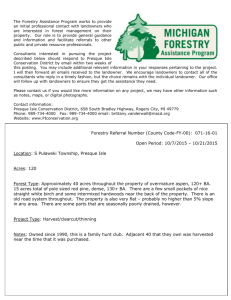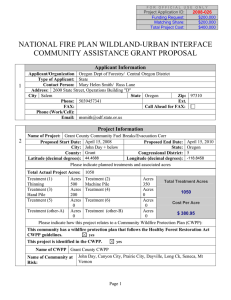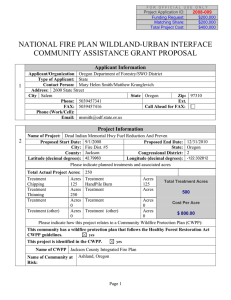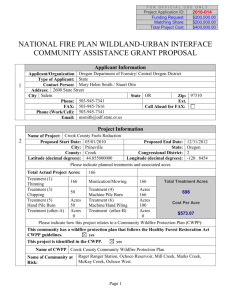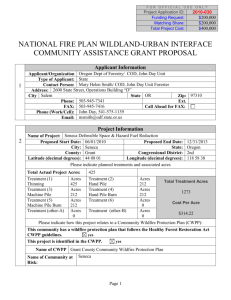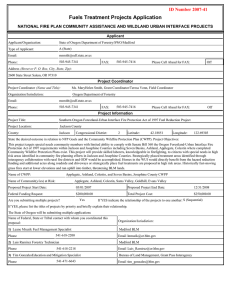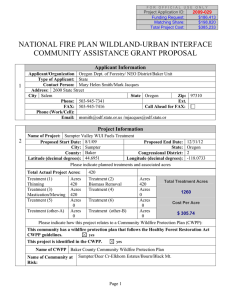Project Summary Form Id Number 2006-147
advertisement
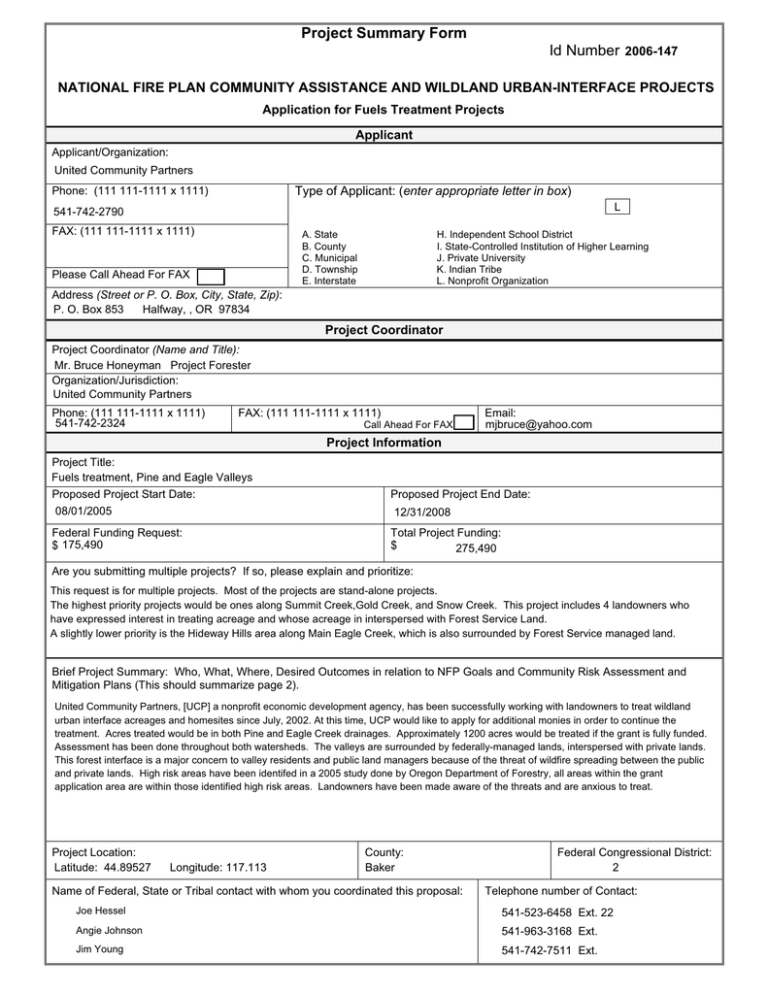
Project Summary Form Id Number 2006-147 NATIONAL FIRE PLAN COMMUNITY ASSISTANCE AND WILDLAND URBAN-INTERFACE PROJECTS Application for Fuels Treatment Projects Applicant Applicant/Organization: United Community Partners Phone: (111 111-1111 x 1111) Type of Applicant: (enter appropriate letter in box) L 541-742-2790 FAX: (111 111-1111 x 1111) A. State B. County C. Municipal D. Township E. Interstate Please Call Ahead For FAX H. Independent School District I. State-Controlled Institution of Higher Learning J. Private University K. Indian Tribe L. Nonprofit Organization Address (Street or P. O. Box, City, State, Zip): P. O. Box 853 Halfway, , OR 97834 Project Coordinator Project Coordinator (Name and Title): Mr. Bruce Honeyman Project Forester Organization/Jurisdiction: United Community Partners Phone: (111 111-1111 x 1111) 541-742-2324 FAX: (111 111-1111 x 1111) Call Ahead For FAX Email: mjbruce@yahoo.com Project Information Project Title: Fuels treatment, Pine and Eagle Valleys Proposed Project Start Date: 08/01/2005 Federal Funding Request: $ 175,490 Proposed Project End Date: 12/31/2008 Total Project Funding: $ 275,490 Are you submitting multiple projects? If so, please explain and prioritize: This request is for multiple projects. Most of the projects are stand-alone projects. The highest priority projects would be ones along Summit Creek,Gold Creek, and Snow Creek. This project includes 4 landowners who have expressed interest in treating acreage and whose acreage in interspersed with Forest Service Land. A slightly lower priority is the Hideway Hills area along Main Eagle Creek, which is also surrounded by Forest Service managed land. Brief Project Summary: Who, What, Where, Desired Outcomes in relation to NFP Goals and Community Risk Assessment and Mitigation Plans (This should summarize page 2). United Community Partners, [UCP] a nonprofit economic development agency, has been successfully working with landowners to treat wildland urban interface acreages and homesites since July, 2002. At this time, UCP would like to apply for additional monies in order to continue the treatment. Acres treated would be in both Pine and Eagle Creek drainages. Approximately 1200 acres would be treated if the grant is fully funded. Assessment has been done throughout both watersheds. The valleys are surrounded by federally-managed lands, interspersed with private lands. This forest interface is a major concern to valley residents and public land managers because of the threat of wildfire spreading between the public and private lands. High risk areas have been identifed in a 2005 study done by Oregon Department of Forestry, all areas within the grant application area are within those identified high risk areas. Landowners have been made aware of the threats and are anxious to treat. Project Location: Latitude: 44.89527 Longitude: 117.113 County: Baker Name of Federal, State or Tribal contact with whom you coordinated this proposal: Federal Congressional District: 2 Telephone number of Contact: Joe Hessel 541-523-6458 Ext. 22 Angie Johnson 541-963-3168 Ext. Jim Young 541-742-7511 Ext. Project Narrative Description Applications for funding must include a narrative response that describes the proposal. Please do not submit responses longer than one page, single space, 12-pitch font. Describe project including, but not limited to: x project relationship to the community risk assessment and x project location (e.g., Watershed, Address mitigation plan neighboring community) these items as applicable: x anticipated outcomes x amount or extent of actions (acres, number of homes, etc.) x project timeline and matching or contributed funds x community partners and their role(s) x proponent’s ability to complete project For this project, explain the level of cooperation, coordination or strategic planning, through a “Local Coordination Group.” If you have not worked with a local coordination group, why not? UCP has been working with local agencies and various landowners in a local coordination group. Is this project adjacent to a current prescribed burn project on federal lands or to one that is planned within the next three years? (Yes/No) Yes Please indicate planned treatments and associated acres: * Treatment Thinning Acres 800 Treatment Hand Piling Acres 200 Treatment Lop and Scatter Acres 100 Treatment Mastication/Mowing Acres 100 If you have a treatment type other than standard types above: Other 1 Acres 0 Other 2 Acres 0 United Community Partners applied for and received federal grants in 2002 and 2003 for interface education, fuels assessments, treatment and feasibility. Those grants accomplished the following: defensable space has been created around 16 home sites and fuels treatment has been completed or approved on greater than 600 acres. An education program was done, consisting of meetings with landowners and mailings. Work was done on a feasibility project. An extensive mapping project was done on the interface acres in conjunction with the assessor's office, this helped to assess which areas were in high priority treatment areas. In addition treatment has been assessed on almost 1100 acres. Funds from these original grants will be depleted and additional treatment areas have been located through this assessment. This grant application is to apply for additional dollars which will be used for treatment of projects which have been identified and assessed. Additional dollars will also be used for education. Projects are located within 1/2 mile of the Forest Service boundary in the Pine and Eagle Valley drainages. Communities within the area are Halfway and Richland [incorporated] and Cornucopia and Sparta [unincorporated]. Incorporated areas contain populations of 490, while the surrounding area contains an additional 1200 people. Partners who will participate in the treatment are local landowners and Oregon Department of Forestry, U. S. Forest Service, Bureau of Land Management and Oregon State University Department of Extension, and Wallowa Resources. Through the grants which have been received so far, strong partnerships have been formed with agencies and land owners. These partnerships will be continued. This continuation will lead to an awareness and willingness to treat interface acres. Acres to be treated are within the high risk areas identified in the Baker County Community Wildfire Protection Plan. This plan was done by Oregon Department of Forestry in conjunction with the fuels assessment done in Pine and Eagle Valleys. The 1200 acres which are projected to be treated with this grant are part of the 11,000 private acres within the forest interface. In addition, approximately 70 homes are within the forest interface; it is our aim to treat fuels around more homes with this grant. Projects funded under this grant have been assessed and work will be started in August,2005. In-kind contributions from United Community Partners will total $32,800. Landowner treatment will be funded at a rate of 75%; landowner contributions will total $48,000. Other agencies will contribute $20,000. United Community Partners is ideally situated to complete work on the fuels treatment and defensable space. All of the infrastructure is in place to do so. The coordinator has been working on this interface project for three years and is very aware of what is needed to accomplish these goals. He has created strong working relationships with landowners and other agencies, something that is important in accomplishing tasks. Other agencies have been invaluable in getting the work assessed and accomplished and in reimbursing landowners. Project Evaluation Criteria Applications for funding must include narrative responses that address the following three criteria. Be sure you address every one briefly, yet thoroughly. Limit your responses to the area provided. 1. Reducing Hazardous Fuels (50 points) A. Describe the community infrastructure that will be protected. B. Explain how the proposal reduces fire behavior in high hazard areas by describing the fuels to be disposed or removed, and the techniques and timing of the treatments. C. How will the proposed treatments be maintained in future years? D. How will you use multi-party monitoring to improve this and future projects? Response: Community infrastructure to be protected include the unincorporated town of Cornucopia, and various homesites surrounded by National Forest lands on East Eagle, East Pine, Gold Creek, Pine Creek, Eagle Creek and Snow Creek. Home sites will be protected by creating a defensable space for 100 to 150 feet around buildings. Forests will be protected by treating timber stands that are too dense, by treating pine stands which contain grand fir and Douglasfir understories, and by treating stands along roads which provide the only entrance to National Forest-managed lands and private homesites. An example of that is road 7735 along East Eagle Creek. Techniques to be used include understory and overstory thinning, disposal of the slash by hand and machine piling, lop and scatter and by using a slash buster. Piles will be burned in the fall in order to lessen the likelihood of insects in the slash. It is expected that landowners will continue to maintain their stand treatments in the future, once the importance of the treatment is understood. Hopefully, programs like this one will continue to be available to help with treatments. Continuing education and field trips to illustrate what has been done will help to monitor both the projects we have already accomplished and the projects which will be done with this grant. Project Evaluation Criteria 2. Increasing Local Capacity (25 points) A. How would the proposal improve or lead to the improvement of the local economy in terms of jobs and sustainable economic activity? B. How many jobs are expected to be created or retained and for how long? (Please distinguish between essentially year-round and seasonal jobs). C. What tools and skills will be gained or utilized as a result of this project? D. Will biomass be utilized; if so, in what manner and how much? Response: It has been the experience of United Community Partners in implementing two past grants that the local economy is improved because of jobs created by these projects. Seven to nine jobs have been created as a result of work done since 2002. Although these were not full time, the jobs were 75% of the year. In addition, one other business is getting licensed to accomplish this work. Approximately 40% of the landowners accomplished their own work. This work was in addition to the seven to nine jobs created. Since the work to be done is increasingly more timber stand improvement, rather than defensable space work, there will be an increase in contract work, thus leading to more jobs in the community. It would be hoped that 10 to 15 part-time jobs would be created in the next 5 years. In an environment with a high unemployment rate, this is an important addition. Workers are learning new forestry skills, such as thinning and piling. Workers are also learning the skill of starting and running a business. Forestry consultants are also being employed doing map work and assessment work on private lands. We continue to study ways to use biomass. We worked closely with David Schmidt of Healthy Forests, Healthy Communities, who produced a Baker County Small Sawmill Analysis. We have also worked with owners of small sawmills in the area, and with carpenters and woodworkers in the area to try to use the biomass. 3. Demonstrating Community and Intergovernmental Collaboration (25 Points) A. How will this project implement a community risk assessment and mitigation plan? Include name of plan, date it was prepared, and local contact to get a copy of the plan if requested. B. How has this treatment been coordinated with adjacent landowners and local/State/Tribal/Federal agencies? C. Identify the cooperators/partners involved in implementation of this project. D. Describe the extent of current local support for the project, including any cost-sharing agreements. Response: All of the areas identified for treatment are within areas described as high priority in the Baker County Community Wildfire Protection Plan. This plan was prepared by Oregon Department of Forestry, and is in the draft stage at present. A copy can be obtained from Angie Johnson at 541-963-3168 or by going to www.odf.state.or.us/area/eastern/northeast/bakerco._cwpp.htm. Treatment acres have been identified through extensive public outreach to landowners [2 meetings, 3 mailings and numerous newspaper articles] and by coordinating with local agencies concerning proposed actions. Approximately 520 acres are within the East Eagle drainage area; the U. S. Forest Service is proposing specific fuels treatment project on Forest Service-managed land within that same drainage. Coordinating the treatment on public and private land would create a much safer fuels environment on both lands. Partners involved in implementing this project include the landowners, Oregon Department of Forestry, U. S. Forest Service, Bureau of Land Management, and Baker and Union Counties. These partners are already working with United Community Partners to implement fuels treatments, this would simply be a continuation of that partnership. At present, over 400 acres and 11 homesites have received treatment through previous grants. Almost 200 acres and 5 sites have been approved for treatment and are in process. All of this treatment was accomplished through cost-sharing agreements. As frequently happens, when landowners notice their neighbors accomplishing fuels treatment in cooperation with agencies, they become interested in doing the same thing on their acreages. This is happening more and more, with more landowners expressing interest in doing fuels treatment. Project Work Form Tasks Time Frame Thinning, fuels reduction, and fuels treatment on Gold and Snow Creek Aug. 2005 United Community Partners, Oregon Department of Forestry, Bureau of Land Management June, 2006 United Community Partners, Baker County, Oregon Department of Forestry July-Aug., 2006 United Community Partners, Baker County, Oregon Department of Forestry August-Sept. 2006 United Community Partners, Oregon Department of Forestry, Hideway Hills, Inc, landowners June-Aug., 2007 United Community partners, Oregon Department of Forestry, Pine Valley Ranch, landowners. Sparta Butte area, Fizz Spring area, thinning, lop and scatter, hand pile Melhorn Butte area, thinning, machine pile Main Eagle treatment, thinning, machine piling Pine Creek, lower portion, thinning, lop and scatter, hand pile, machine pile, slash buster East Eagle Creek, thinning, defensable space creation, hand pile, machine pile, lop, slash buster Responsible Party June-Dec., 2008 United Community Partners, United States Forest Service, Oregon Department of Forestry, various landowners. Project Budget landowners Cost Category Description Federal Agency Applicant ODF Partner 1 USFS Partner 2 Total Partner 3 Personnel Bruce Honeyman Subtotal $15,000 $0 $0 $0 $0 $15,000 $0 $0 $0 $0 $0 $0 $15,000 $0 $0 $0 $0 $15,000 $0 $0 $0 Fringe Benefits Subtotal $0 $0 $0 $0 $0 $0 $0 $0 $0 $0 $0 $0 $0 $0 $0 $10,000 $0 $0 $0 $0 $10,000 $0 $0 $0 $10,000 $0 $0 $0 $0 $0 $0 $10,000 $0 $20,000 $0 $0 $0 $20,000 $0 $0 $0 $0 $0 $0 $0 $20,000 $0 $0 $0 $20,000 $5,000 $12,000 $0 $0 $0 $17,000 $0 $0 $0 $0 $0 $0 $5,000 $12,000 $0 $0 $0 $17,000 $145,490 $0 $0 $10,000 $10,000 $165,490 $0 $0 $0 $0 $0 $0 $0 $145,490 $0 $10,000 $10,000 $165,490 $0 $0 $48,000 $0 $0 $48,000 $0 $0 $0 $0 $0 $0 $0 $0 $48,000 $0 $0 $48,000 $175,490 $32,000 $48,000 $10,000 $10,000 $275,490 $0 $0 $0 $0 $0 $0 Travel $0 Subtotal Equipment Subtotal Supplies Subtotal Contractual Subtotal Other in-kind work Subtotal Total Costs Project (Program) Income1 ___________________________________ 1 Program income is the gross revenue generated by a grant or cooperative agreement supported activity during the life of the grant. Program income can be made by recipients from fees charged for conference or workshop attendance, from rental fees earned from renting out real property or equipment acquired with grant or cooperative agreement funds, or from the sale of commodities or items developed under the grant or cooperative agreement. The use of Program Income during the project period may require prior approval by the granting agency.
